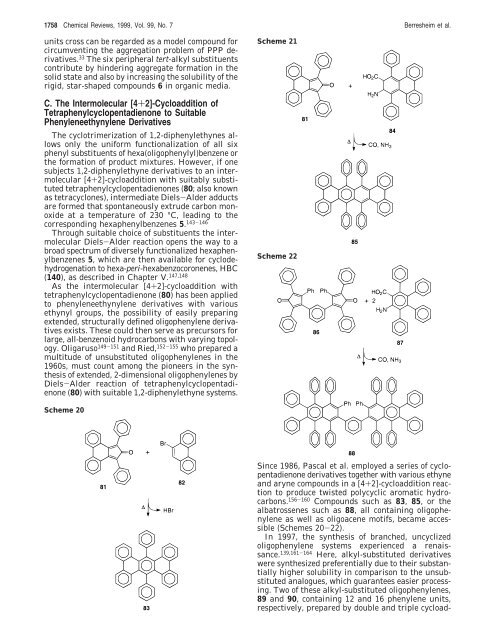Polyphenylene Nanostructures - Cluster for Molecular Chemistry
Polyphenylene Nanostructures - Cluster for Molecular Chemistry
Polyphenylene Nanostructures - Cluster for Molecular Chemistry
Create successful ePaper yourself
Turn your PDF publications into a flip-book with our unique Google optimized e-Paper software.
1758 Chemical Reviews, 1999, Vol. 99, No. 7 Berresheim et al.<br />
units cross can be regarded as a model compound <strong>for</strong><br />
circumventing the aggregation problem of PPP derivatives.<br />
33 The six peripheral tert-alkyl substituents<br />
contribute by hindering aggregate <strong>for</strong>mation in the<br />
solid state and also by increasing the solubility of the<br />
rigid, star-shaped compounds 6 in organic media.<br />
C. The Intermolecular [4+2]-Cycloaddition of<br />
Tetraphenylcyclopentadienone to Suitable<br />
Phenyleneethynylene Derivatives<br />
The cyclotrimerization of 1,2-diphenylethynes allows<br />
only the uni<strong>for</strong>m functionalization of all six<br />
phenyl substituents of hexa(oligophenylyl)benzene or<br />
the <strong>for</strong>mation of product mixtures. However, if one<br />
subjects 1,2-diphenylethyne derivatives to an intermolecular<br />
[4+2]-cycloaddition with suitably substituted<br />
tetraphenylcyclopentadienones (80; also known<br />
as tetracyclones), intermediate Diels-Alder adducts<br />
are <strong>for</strong>med that spontaneously extrude carbon monoxide<br />
at a temperature of 230 °C, leading to the<br />
corresponding hexaphenylbenzenes 5. 143-146<br />
Through suitable choice of substituents the intermolecular<br />
Diels-Alder reaction opens the way to a<br />
broad spectrum of diversely functionalized hexaphenylbenzenes<br />
5, which are then available <strong>for</strong> cyclodehydrogenation<br />
to hexa-peri-hexabenzocoronenes, HBC<br />
(140), as described in Chapter V. 147,148<br />
As the intermolecular [4+2]-cycloaddition with<br />
tetraphenylcyclopentadienone (80) has been applied<br />
to phenyleneethynylene derivatives with various<br />
ethynyl groups, the possibility of easily preparing<br />
extended, structurally defined oligophenylene derivatives<br />
exists. These could then serve as precursors <strong>for</strong><br />
large, all-benzenoid hydrocarbons with varying topology.<br />
Oligaruso 149-151 and Ried, 152-155 who prepared a<br />
multitude of unsubstituted oligophenylenes in the<br />
1960s, must count among the pioneers in the synthesis<br />
of extended, 2-dimensional oligophenylenes by<br />
Diels-Alder reaction of tetraphenylcyclopentadienone<br />
(80) with suitable 1,2-diphenylethyne systems.<br />
Scheme 20<br />
Scheme 21<br />
Scheme 22<br />
Since 1986, Pascal et al. employed a series of cyclopentadienone<br />
derivatives together with various ethyne<br />
and aryne compounds in a [4+2]-cycloaddition reaction<br />
to produce twisted polycyclic aromatic hydrocarbons.<br />
156-160 Compounds such as 83, 85, or the<br />
albatrossenes such as 88, all containing oligophenylene<br />
as well as oligoacene motifs, became accessible<br />
(Schemes 20-22).<br />
In 1997, the synthesis of branched, uncyclized<br />
oligophenylene systems experienced a renaissance.<br />
139,161-164 Here, alkyl-substituted derivatives<br />
were synthesized preferentially due to their substantially<br />
higher solubility in comparison to the unsubstituted<br />
analogues, which guarantees easier processing.<br />
Two of these alkyl-substituted oligophenylenes,<br />
89 and 90, containing 12 and 16 phenylene units,<br />
respectively, prepared by double and triple cycload-

















